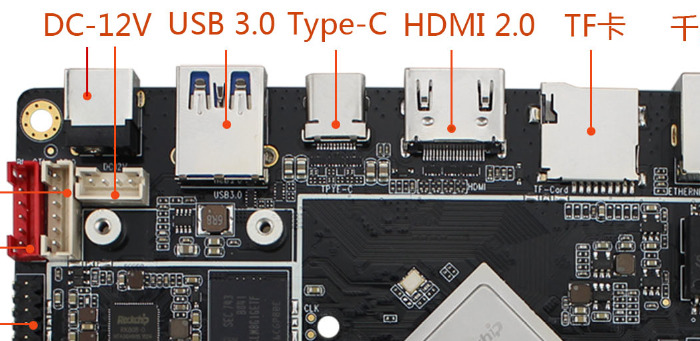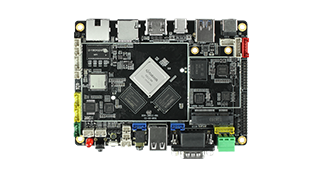1. ADB use¶
1.1. Preface¶
ADB (the full name is the Android Debug Bridge) is the command-line debugging tool for Android, and it can complete a variety of functions, such as tracking the system logs, uploading and downloading the files, installing the applications, etc.
1.1.1. USB ADB¶
AIO-3399C connects device Type-C port and host with Type-C data cable.
AIO-3399C(AI) use a dual male USB date cable connect host and USB3.0 of Mianboard, then check connect to PC in the corresponding path according to the current Android version.
For Android 7.1 and Android 8.1, select setting > USB, and then check connect to PC
For Android 10.0, select setting > connected devices, and then check connect to PC

When the device-side status bar prompts `USB debugging connection’, debugging can be carried out:
adb devices
adb shell
1.1.2. Network the ADB¶
Setting->Developer Option->ADB over network
check the AIO-3399C IP address, Use command under the PC:
adb connect + IP
adb shell
1.2. Adb Installation under Windows¶
First, please reference Install RK USB driver to get the driver ready.
Then go to http://www.t-firefly.com/share/index/index/id/6afafdf7c54b8eb95e81156d94e54db5.html to download adb.zip, uncompress it to C:\adb to ease later use.
Open a cmd window, input:
cd C:\adb
adb shell
If everything works, you have entered adb shell, and can run all kinds of commands available in device.
1.3. ADB installation on Ubuntu¶
Install ADB:
sudo apt-get install android-tools-adb
Add device identity:
mkdir -p ~/.android
vi ~/.android/adb_usb.ini
# append following line
0x2207
Add udev rule:
sudo vi /etc/udev/rules.d/51-android.rules
# append following line:
SUBSYSTEM=="usb", ATTR{idVendor}=="2207", MODE="0666"
Replug the USB cable, or run the following command to make the udev rule work:
sudo udevadm control --reload-rules
sudo udevadm trigger
Restart adb daemon:
sudo adb kill-server
adb start-server
1.4. Frequently-used ADB Commands¶
1.4.1. Connection Manage¶
List all the connected devices:
adb devices
If there are multiple devices connected, the device serial number is needed to distinguish:
export ANDROID_SERIAL=<device serial number>
adb shell ls
ADB can also use the TCP/IP network to connect to device:
# Restart ADB on the device side and listen at TCP port 5555.
adb tcpip 5555
# Now, the Type-C cable can be disconnected.
# Connect to the device, whose IP is 192.168.1.100 here.
adb connect 192.168.1.100:5555
# Disconnect the device
adb disconnect 192.168.1.100:5555
1.4.2. Debugging¶
Get System Log (adb logcat)
Usage
adb logcat [Options] [Label]
For example:
# View all logs.
adb logcat
# Show only part of the logs.
adb logcat -s WifiStateMachine StateMachine
1.4.3. Running Commands (adb shell)¶
1.4.3.1. Get Details of System (adb bugreport)¶
adb bugreport is used for bug report, which contains lots of useful information about system.
For example:
adb bugreport
# Save to host, then open it with text editor to view ADB
adb bugreport >bugreport.txt
1.4.4. Root permission¶
If TARGET_BUILD_VARIANT is in userdebug mode, you need to run it to get root permission:
adb root
Switch ADB’s device side to root mode so ADB remount and other commands that require root can succeed.
1.5. Application Manage¶
1.5.1. Install Application (adb install)¶
Usage:
adb install [Options] Application.apk
Options incldue:
-l forward-lock
-r Reinstall application, keeping previous data
-s Install to SD card, instead of internal storage
For example:
# Install facebook.apk
adb install facebook.apk
# Upgrade twitter.apk
adb install -r twitter.apk
If installation is successful, it will prompt “Success”; otherwise, it will fail with following messages:
* INSTALL_FAILED_ALREADY_EXISTS: You need to reinstall with the -r parameter at this point.
* INSTALL_FAILED_SIGNATURE_ERROR: The applied signatures may not be the same, and may be due to differences between the release and debug signatures. If you are sure that the APK file signature is ok, you can uninstall the old application by using the [adb uninstall](http://www.t-firefly.com/upload/#adb_uninstall) command.Then install again.
* INSTALL_FAILED_INSUFFICIENT_STORAGE: Insufficient storage space, you need to check the device storage.
1.5.2. Uninstall Application (adb uninstall)¶
Usage:
adb uninstall Application package name
For example:
adb uninstall com.android.chrome
The package name of application can be listed with:
adb shell pm list packages -f
The running result:
⋯
package:/system/app/Bluetooth.apk=com.android.bluetooth
⋯
The apk file is ahead,and the follows is the corresponding package name.
1.5.3. Commandline Help (adb help)¶
Android Debug Bridge version 1.0.31
-a - directs adb to listen on all interfaces for a connection
-d - directs command to the only connected USB device
returns an error if more than one USB device is present.
-e - directs command to the only running emulator.
returns an error if more than one emulator is running.
-s <specific device> - directs command to the device or emulator with the given
serial number or qualifier. Overrides ANDROID_SERIAL
environment variable.
-p <product name or path> - simple product name like 'sooner', or
a relative/absolute path to a product
out directory like 'out/target/product/sooner'.
If -p is not specified, the ANDROID_PRODUCT_OUT
environment variable is used, which must
be an absolute path.
-H - Name of adb server host (default: localhost)
-P - Port of adb server (default: 5037)
devices [-l] - list all connected devices
('-l' will also list device qualifiers)
connect <host>[:<port>] - connect to a device via TCP/IP
Port 5555 is used by default if no port number is specified.
disconnect [<host>[:<port>]] - disconnect from a TCP/IP device.
Port 5555 is used by default if no port number is specified.
Using this command with no additional arguments
will disconnect from all connected TCP/IP devices.
device commands:
adb push [-p] <local> <remote>
- copy file/dir to device
('-p' to display the transfer progress)
adb pull [-p] [-a] <remote> [<local>]
- copy file/dir from device
('-p' to display the transfer progress)
('-a' means copy timestamp and mode)
adb sync [ <directory> ] - copy host->device only if changed
(-l means list but don't copy)
(see 'adb help all')
adb shell - run remote shell interactively
adb shell <command> - run remote shell command
adb emu <command> - run emulator console command
adb logcat [ <filter-spec> ] - View device log
adb forward --list - list all forward socket connections.
the format is a list of lines with the following format:
<serial> " " <local> " " <remote> "\n"
adb forward <local> <remote> - forward socket connections
forward specs are one of:
tcp:<port>
localabstract:<unix domain socket name>
localreserved:<unix domain socket name>
localfilesystem:<unix domain socket name>
dev:<character device name>
jdwp:<process pid> (remote only)
adb forward --no-rebind <local> <remote>
- same as 'adb forward <local> <remote>' but fails
if <local> is already forwarded
adb forward --remove <local> - remove a specific forward socket connection
adb forward --remove-all - remove all forward socket connections
adb jdwp - list PIDs of processes hosting a JDWP transport
adb install [-l] [-r] [-d] [-s] [--algo <algorithm name> --key <hex-encoded key> --iv <hex-encoded iv>] <file>
- push this package file to the device and install it
('-l' means forward-lock the app)
('-r' means reinstall the app, keeping its data)
('-d' means allow version code downgrade)
('-s' means install on SD card instead of internal storage)
('--algo', '--key', and '--iv' mean the file is encrypted already)
adb uninstall [-k] <package> - remove this app package from the device
('-k' means keep the data and cache directories)
adb bugreport - return all information from the device
that should be included in a bug report.
adb backup [-f <file>] [-apk|-noapk] [-obb|-noobb] [-shared|-noshared] [-all] [-system|-nosystem] [<packages...>]
- write an archive of the device's data to <file>.
If no -f option is supplied then the data is written
to "backup.ab" in the current directory.
(-apk|-noapk enable/disable backup of the .apks themselves
in the archive; the default is noapk.)
(-obb|-noobb enable/disable backup of any installed apk expansion
(aka .obb) files associated with each application; the default
is noobb.)
(-shared|-noshared enable/disable backup of the device's
shared storage / SD card contents; the default is noshared.)
(-all means to back up all installed applications)
(-system|-nosystem toggles whether -all automatically includes
system applications; the default is to include system apps)
(<packages...> is the list of applications to be backed up. If
the -all or -shared flags are passed, then the package
list is optional. Applications explicitly given on the
command line will be included even if -nosystem would
ordinarily cause them to be omitted.)
adb restore <file> - restore device contents from the <file> backup archive
adb help - show this help message
adb version - show version num
scripting:
adb wait-for-device - block until device is online
adb start-server - ensure that there is a server running
adb kill-server - kill the server if it is running
adb get-state - prints: offline | bootloader | device
adb get-serialno - prints: <serial-number>
adb get-devpath - prints: <device-path>
adb status-window - continuously print device status for a specified device
adb remount - remounts the /system partition on the device read-write
adb reboot [bootloader|recovery] - reboots the device, optionally into the bootloader or recovery program
adb reboot-bootloader - reboots the device into the bootloader
adb root - restarts the adbd daemon with root permissions
adb usb - restarts the adbd daemon listening on USB
adb tcpip <port> - restarts the adbd daemon listening on TCP on the specified port
networking:
adb ppp <tty> [parameters] - Run PPP over USB.
Note: you should not automatically start a PPP connection.
<tty> refers to the tty for PPP stream. Eg. dev:/dev/omap_csmi_tty1
[parameters] - Eg. defaultroute debug dump local notty usepeerdns
adb sync notes: adb sync [ <directory> ]
<localdir> can be interpreted in several ways:
- If <directory> is not specified, both /system and /data partitions will be updated.
- If it is "system" or "data", only the corresponding partition
is updated.
environmental variables:
ADB_TRACE - Print debug information. A comma separated list of the following values
1 or all, adb, sockets, packets, rwx, usb, sync, sysdeps, transport, jdwp
ANDROID_SERIAL - The serial number to connect to. -s takes priority over this if given.
ANDROID_LOG_TAGS - When used with the logcat option, only these debug tags are printed.
